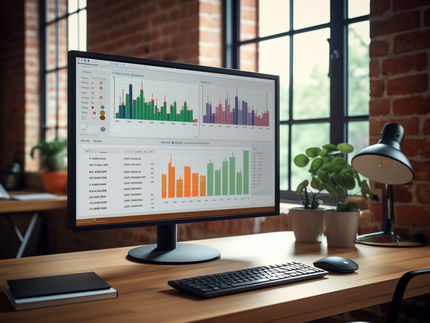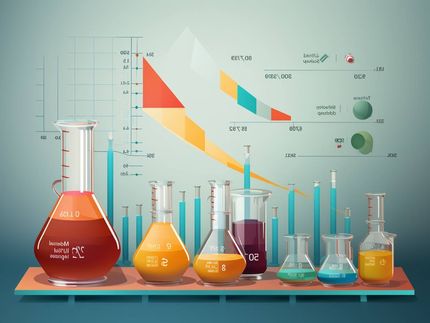WACKER achieves strong sales growth in Q3 2022 and confirms full-year forecast
Full-year forecast confirmed in the upper half of the range
Wacker Chemie AG finished Q3 2022 with significant sales growth. From July through September, the Munich-based chemical company generated sales of €2,132.2 million. That was 29 percent higher than in the same period last year (€1,658.6 million). Relative to a quarter earlier (€2,174.2 million), sales declined by 2 percent due to reduced demand. Higher selling prices were the main growth driver compared with a year earlier. Sales also benefited from positive exchange-rate effects due to the stronger US dollar. On the other hand, volumes that were somewhat lower overall compared with a year earlier had a dampening effect on sales.
In Q3 2022, WACKER posted EBITDA (earnings before interest, taxes, depreciation and amortization) of €456.6 million (Q3 2021: €449.5 million), up 2 percent year over year. However, surging energy and raw-material prices in particular held back earnings growth, reducing EBITDA by more than €300 million year over year. Compared with a quarter earlier (€625.8 million), EBITDA decreased 27 percent. The Group’s EBITDA margin was 21.4 percent for the three months from July through September 2022. A year earlier, the figure was 27.1 percent, while the prior quarter’s EBITDA margin was 28.8 percent.
Group earnings before interest and taxes (EBIT) came to €350.7 million in the reporting quarter, down 2 percent from a year earlier (€358.4 million). The EBIT margin was 16.4 percent (Q3 2021: 21.6 percent). Compared with Q2 2022 (€528.5 million), EBIT declined 34 percent. Net income for the quarter amounted to €258.9 million (Q3 2021: €264.5 million) and earnings per share came in at €5.08 (Q3 2021: €5.22).
WACKER confirmed its full-year forecast of July 28 in the upper half of the range. EBITDA is now expected to come in between €2.1 billion and €2.3 billion (previous guidance: between €1.8 billion and €2.3 billion). Higher energy, raw-material and logistics costs are likely to impact EBITDA by around €1.3 billion to €1.4 billion (previous guidance: €1.5 billion). The current forecast takes this into account. WACKER continues to expect full-year sales to come in between €8 billion and €8.5 billion.
Given the potential for major restrictions in natural gas supplies and the knock-on effects for production, WACKER had previously taken the precaution of factoring in a further €200–250 million in additional costs at the lower end of its EBITDA forecast, on top of the energy and raw-material price increases already taken into account. As the levels in German gas reservoirs are now high, the company considers the risk of gas supply shortages for its own production facilities to be low. Continuing high polysilicon prices are a further reason for WACKER’s updated earnings forecast.
“Against a backdrop of rising macroeconomic and geopolitical challenges, WACKER fared very well in the third quarter,” said CEO Christian Hartel in Munich on Thursday. “Despite even higher energy costs, we once again succeeded in growing both our sales and EBITDA year over year. I see this as clear proof of our competitive¬ness amid the current, more difficult environment and of the resilience of our business model.”
At the same time, Hartel underscored that ever higher inflation rates across the globe, rising interest rates, extremely high energy prices in Europe and slowing consumer spending would not be without conse-quences for WACKER. “In summer already, we noted a drop in or¬ders in a number of segments, especially in the construction industry. I assume this trend will continue throughout the fourth quarter and into early next year,” Hartel said. He added that WACKER would not be able to completely decouple itself in the long term from the effects of a recession that more and more economic analysts are expecting to impact Germany and Europe.
In his words, it is essential that politicians make the right decisions without delay in order to mitigate the effects of high energy prices on companies and consumers and ensure supply security. “As long as the energy crisis persists, we will need all available fuels to power the grid – renewables just as much as coal and the nuclear power still on stream,” emphasized Hartel.
Hartel remained optimistic as regards WACKER’s medium-term prospects: “Our strategic focus on specialty chemical products with high value-added for our customers, on highest-quality polysilicon for semiconductors and solar applications, and on the active expansion of our biotechnological activities contributes substantially to strengthening WACKER’s resilience and ensuring the company remains robust.” The goal is to increase Group sales to over €10 billion by 2030, while still maintaining high profitability.
Regions
In Q3 2022, Group sales increased year over year in every region, mainly due to higher selling prices. The biggest increase percentage-wise was in the Americas, where sales climbed 46 percent to €346.7 million (Q3 2021: €237.5 million), due in part to exchange-rate effects. Sales in Asia reached €965.8 million, up 37 percent from €707.5 mil¬lion a year earlier. In Europe, sales rose 12 percent to €714.5 million (Q3 2021: €638.2 million).
Capital Expenditures and Net Cash Flow
In Q3 2022, the Group’s capital expenditures came in at €131.4 million (Q3 2021: €86.3 million), up 52 percent year over year. The investment focus was on expanding capacity at all four divisions.
WACKER’s net cash flow amounted to €295.8 million in Q3 2022 (Q3 2021: €425.9 million). This year-over-year decline of 31 percent was due to a sales-related increase in working capital and higher capital expenditures.
Employees
WACKER’s global workforce grew in the reporting quarter. The Group had 15,476 employees on September 30, 2022 (June 30, 2022: 15,250). At the end of the quarter, 10,255 employees worked at WACKER sites in Germany (June 30, 2022: 10,111) and 5,221 at international locations (June 30, 2022: 5,099).
Business Divisions
In Q3 2022, WACKER SILICONES generated total sales of €889.6 million (Q3 2021: €680.2 million), up 31 percent year over year. The increase was chiefly attributable to higher selling prices and an im-proved product mix containing a larger proportion of high-margin specialty silicones. Sales increased substantially year over year across virtually all application areas. Growth was especially pro¬nounced, for instance, in silicones for the healthcare sector and wound care as well as for industrial and adhesives applications. Exchange-rate changes were a further positive factor impacting sales. Sales fell 5 percent relative to a quarter earlier (€936.3 million), mainly due to a decrease in volumes. WACKER SILICONES’ EBITDA reached €197.5 million in the reporting quarter, 23 percent higher than a year earlier (€160.5 million). Compared with the preceding quarter (€276.5 million), however, the division’s EBITDA was down 29 percent. This decrease was due not only to the drop in sales, but also to the impact of higher energy and raw-material costs. The EBITDA margin in Q3 2022 was 22.2 percent, after 23.6 percent in Q3 2021 and 29.5 percent in the preceding quarter.
Sales at WACKER POLYMERS totaled €504.0 million in the report¬ing quarter, 8 percent higher than a year earlier (€468.8 million). Higher selling prices were the main growth driver, while changes in exchange rates had a positive effect as well. Sales fell 9 percent relative to the preceding quarter (€553.3 million), mainly due to de¬creased sales volumes. In Q3 2022, WACKER POLYMERS posted EBITDA of €60.3 million, compared with €84.5 million a year earlier. This decline of 29 percent was due not only to lower sales volumes, but also to higher energy and raw-material prices and to a scheduled plant shutdown at the Burghausen site. Compared with the preceding quarter (€91.2 million), EBITDA was down 34 percent due to reduced volumes and the higher cost of goods sold – also as a result of the plant shutdown already mentioned. The EBITDA margin was 12.0 percent in the reporting quarter, after 18.0 percent a year earlier and 16.5 percent in the preceding quarter.
WACKER BIOSOLUTIONS generated total sales of €88.7 million in Q3 2022. That was 14 percent higher than a year earlier (€78.0 mil¬lion) and 5 percent more than the prior quarter (€84.1 million). This sales growth was due primarily to improved prices and higher sales volumes. Cysteine business, for instance, performed particularly well in the reporting period. Changes in exchange rates also had a posi¬tive effect on sales. WACKER BIOSOLUTIONS’ reporting-quarter EBITDA came in at €4.4 million. That was €7.0 million less than the year-earlier figure of €11.4 million and €3.7 million less compared with the prior quarter (€8.1 million). One of the reasons for this decline was the upfront costs incurred for a technical competence center for mRNA actives at the Halle site. The EBITDA margin was 5.0 percent, versus 14.6 percent a year earlier and 9.6 percent in the prior quarter.
WACKER POLYSILICON posted total sales of €619.4 million in the reporting quarter. That was 52 percent higher than in the same period last year (€408.9 million). The main driver of this increase was signifi-cantly higher average prices for solar-grade silicon, but slightly higher volumes year over year contributed to the sales trend as well. Prices for semiconductor-grade silicon also rose year over year, while the share of this product in the total sales volume grew further. Relative to the preceding quarter (€568.2 million), sales were up 9 percent. WACKER POLYSILICON’s reporting-quarter EBITDA came in at €190.5 million. That was 5 percent lower relative to a year earlier (€200.8 million) amid surging energy and raw-material costs. Com-pared with a quarter earlier (€213.8 million), EBITDA contracted by 11 percent, chiefly due to higher production costs. From July through September 2022, the division’s EBITDA margin was 30.8 percent, after 49.1 percent in Q3 2021 and 37.6 percent in Q2 2022.
Outlook
WACKER detailed its projections for the Group’s performance this year in the Outlook section of its 2021 Annual Report.
In view of the positive business trend, the company had already revised its sales forecast upward on presentation of its figures for Q1 2022. When presenting its half-yearly report on July 28, 2022, WACKER again raised its full-year sales forecast, along with that for its key earnings indicators. Now, the company has confirmed its EBITDA forecast in the upper half of the range originally projected.
Full-year EBITDA for 2022 is now expected to come in between €2.1 billion and €2.3 billion (previous guidance: between €1.8 billion and €2.3 billion). Higher energy, raw-material and logistics costs are likely to impact EBITDA by around €1.3 billion to €1.4 billion (previous guidance: €1.5 billion). This is factored into the current forecast. WACKER continues to expect full-year sales to come in between €8 billion and €8.5 billion.
Given the potential for major restrictions in natural gas supplies and the knock-on effects for production, WACKER had previously taken the precaution of factoring in a further €200–250 million in additional costs at the lower end of its EBITDA forecast, on top of the energy and raw-material price increases already taken into account. As the levels in German gas reservoirs are now high, the company considers the risk of gas supply shortages for its own production facilities to be low. Continuing high polysilicon prices are a further reason for WACKER’s more precise earnings forecast.
The new forecast for EBITDA also changes the estimate for the full-year EBITDA margin, which is now expected to be slightly higher than last year (previous guidance: roughly on par with last year). Full-year capital expenditures are likely to come in at around €550 million (pre-vious guidance: between €550 million and €600 million). Guidance for the remaining financial KPIs is unchanged versus the forecasts made in the 2021 Annual Report.



























































